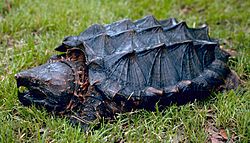| Macrochelys Temporal range: | |
|---|---|
 | |
| Alligator snapping turtle (Macrochelys temminckii) | |
| Scientific classification | |
| Kingdom: | Animalia |
| Phylum: | Chordata |
| Class: | Reptilia |
| Order: | Testudines |
| Suborder: | Cryptodira |
| Family: | Chelydridae |
| Genus: | Macrochelys Gray, 1856 [1] |
| Type species | |
| Macrochelys temminckii Troost, 1835 | |
| Synonyms [2] | |
Macrochelys is a genus of very large freshwater turtles in the family Chelydridae, native to the Southeastern and Midwestern United States. Only a single extant species was recognized until 2014, when a study divided it into two or possibly three species. [3] These turtles are easily recognized by three distinct dorsal ridges with raised spikes.
